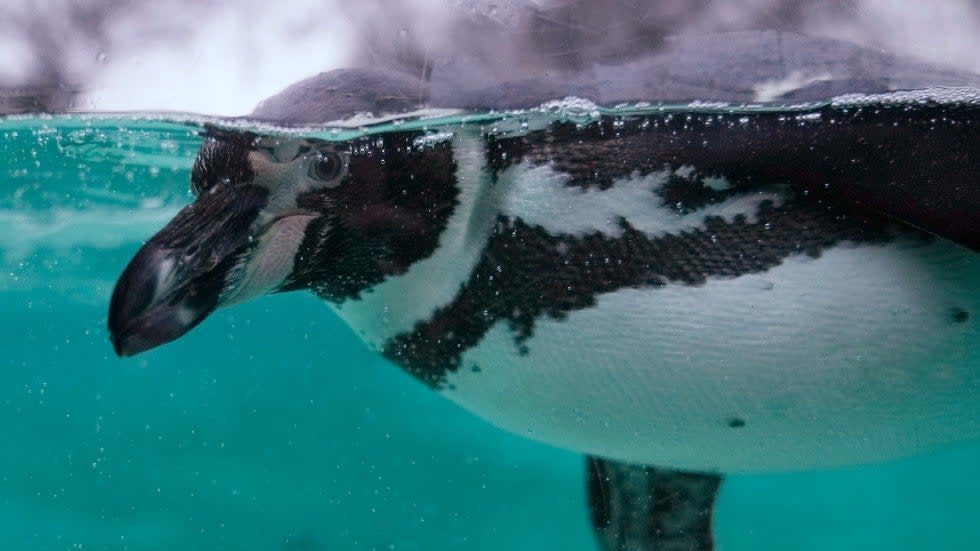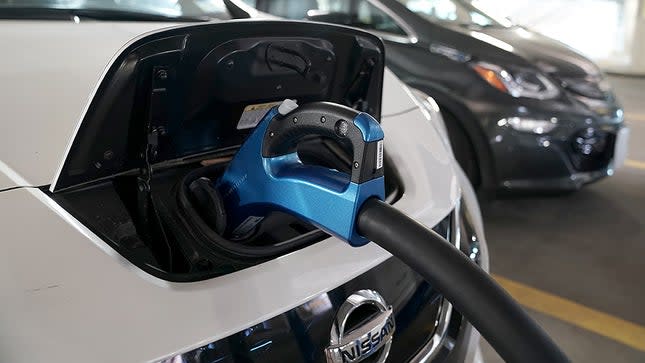Equilibrium/Sustainability — Seabirds covered in oil after volcanic eruption

- Oops!Something went wrong.Please try again later.
Today is Monday. Welcome to Equilibrium, a newsletter that tracks the growing global battle over the future of sustainability. Subscribe here: thehill.com/newsletter-signup.
A Lima zoo is scrambling to save more than 40 seabirds, including protected Humboldt penguins, after waves from a volcanic eruption in the South Pacific splashed 6,000 barrels of crude oil along Peru's coastline, Agence France-Presse reported.
A team of veterinarians is caring for the birds, who were brought to the Parque de Las Leyendas zoo after being rescued from the polluted beaches, according to the AFP story. The vets are bathing the animals in special detergent to remove the suffocating oil.
"We have never seen anything like this in the history of Peru," biologist Liseth Bermudez told AFP.
Today we'll take a look at another fossil fuel crisis - a natural gas shortage in Europe that could escalate amid a possible Russian invasion of Ukraine - and what the U.S. is trying to help do about it. Then we'll look at how omicron-driven labor shortages are bringing a new waves of shortages to a food system already weakened by years of pandemic.
For Equilibrium, we are Saul Elbein and Sharon Udasin. Please send tips or comments to Saul at selbein@thehill.com or Sharon at sudasin@thehill.com. Follow us on Twitter: @saul_elbein and @sharonudasin.
Let's get to it.
Averting EU gas shortages

The Biden administration is piecing together a multinational strategy to step up the production of liquefied natural gas (LNG) in the event a Russian invasion of Ukraine exacerbates gas shortages across Europe, CNN reported.
What's going on with Russia and Ukraine? The British Foreign Office announced on Saturday that it had exposed a Russian plan to install a friendly government in Ukraine, backing previous U.S. assessments of the situation, according to The Wall Street Journal.
While neither the U.K. nor the U.S. have revealed precisely how Russia might go about doing so, both Western and Ukrainian officials indicated that Moscow is weighing several options, the Journal reported.
Among these options are a military invasion and a destabilization campaign aimed at overthrowing Ukraine's pro-Western president, Volodymyr Zelensky, according to the Journal.
U.S. may deploy troops to NATO: President Biden is considering sending 1,000 to 5,000 troops to its NATO allies in the Baltics and Eastern Europe, The New York Times reported on Monday, citing administration officials.
If Biden does proceed, this move would mark "a major pivot" for the administration, which had been "taking a restrained stance on Ukraine, out of fear of provoking Russia into invading," according to the Times.
NATO has sent ships, jets to Eastern Europe: For its part, NATO announced on Monday that it was deploying additional fighter jets and ships to Eastern Europe, as our colleague Mychael Schnell reported for The Hill.
"NATO Allies are putting forces on standby and sending additional ships and fighter jets to NATO deployments in eastern Europe, reinforcing Allied deterrence and defense as Russia continues its military build-up in and around Ukraine," the alliance said in a statement.
Kremlin spokesman Dmitry Peskov said on Monday that NATO's activity near the Russian border "cannot be ignored by our military, which is responsible for the security of our country," according to the Saint Petersburg-based TASS News Agency.
NATURAL GAS PLANTS LOSING MILLIONS OF DOLLARS TO LEAKS
The EU currently relies on Russia for 41 percent of its natural gas, according to the European Commission's Eurostat database. Next in line is Norway (16 percent), Algeria (8 percent) and Qatar (5 percent).
Gas reserves in the underground gas storage facilities of Europe and Ukraine hit a record low on Monday, Russia's state-owned gas company, Gazprom, reported, according to TASS News Agency.
With tensions on the horizon, the State Department has spent the past six to eight weeks formulating a global strategy to redirect and boost natural gas supplies to Europe from around the world in the event of an invasion, a senior U.S. official told CNN.
Where might the gas come from? While the countries engaging in the discussion include Norway and Qatar, U.S. officials have reached out around the world to ascertain what supplies are necessary to get through the winter and spring, according to CNN.
Qatar is one of the largest manufacturers of LNG in the world, although the country currently sells most of its fuel to East Asian countries, Al Jazeera reported.
On Friday, Bloomberg reported that President Biden planned to asked Qatar's emir, Sheikh Tamim bin Hamad Al Thani, to visit the White House as soon as possible, citing "people familiar with the matter."
German dependence on Russian gas plays critical role: Germany has become particularly reliant on Russian gas, due to the country's decision to shut down its last three nuclear power plants this year, according to the Journal. Meanwhile, the country has planned to shutter all its coal plants by 2038, the Journal reported.
With the construction of the Nord Stream 2 pipeline - a pipeline from Russia to Germany through the Baltic Sea - Germany will be able to receive double the capacity of Russian gas exports, according to the Journal.
Last words: "The decision to phase out nuclear and coal at the same time has made Germany fully dependent on Russian gas and vulnerable to the possibility that Russia could use energy as a weapon," Gustav Gressel, senior policy fellow at the European Council on Foreign Relations, told the Journal.
Labor, wage shortages threaten supply chains

Omicron has infected tens of thousands grocery and industrial food workers, battering employees and stopping up supply chains already disrupted by two years of the pandemic.
That's created a situation reminiscent of the health care industry: years of attrition in the face of the virus has led to a system teetering on the edge of breakdown.
First words: "I don't know how much they pay [grocery store workers] but I figure they should at least make 20 or 25 bucks an hour, especially if they have a child and a home," customer Michael Jones told The Denver Post.
"The cost of living is going up, groceries are going up. Everything is going up except the working wage," Jones added.
Behind the quote: Striking workers at King Soopers - the Kroger-owned chain where Jones was shopping - seem to have reached a tentative deal after a 10-day strike, as workers demanded higher pay in the face of the ongoing coronavirus pandemic.
Though the terms of the agreement aren't public, the United Food and Commercial Workers Local 7 union have demanded a starting pay of $18.56 an hour, and have rejected an offered $170-million package that would have raised starting wages to $16 an hour.
Why? Because they say it isn't enough money to make up for the risk they've had to take on over the last two years, particularly after Kroger ended its $2 an hour hazard pay (the "Hero Bonus") in May 2021, amid news that its CEO had earned $22 million in bonuses the previous year, according to the Los Angeles Times.
Food workers face hunger: Though Kroger continued to pay lump-sum bonuses, for many workers that isn't enough for a decent life, according to an Economic Roundtable study released earlier this month.
"The living and working conditions of Kroger workers have declined markedly over the past 20 years," the report found. "Kroger's current low-wage, part-time workforce strategy relies on poorly-paid, part-time workers with constantly changing schedules."
Inflation-adjusted wages have fallen 11 to 22 percent since 1990, according to the report.
The findings were stark: Three-quarters of Kroger workers can't reliably afford balanced and healthy food, forcing them to skip meals or go hungry to feed their children, the report found. Two-thirds say they don't earn enough to pay for basic necessities like rent. And 14 percent have either been homeless over the past year, or are homeless now.
A living wage would require Kroger to pay workers about $45,760 a year, up from a current average of about $30,000, the report found.
THIS FEEDS INTO THE BARE-SHELVES PROBLEM
The combination of stretched supply lines and a vulnerable workforce has meant that omicron has laid waste to food business from the factories who make processed goods like frozen cookie and biscuit dough to the stores that sell them, The Wall Street Journal reported.
Data points show the damage: Labor shortages at one Wisconsin trucking company were so bad that the president spent 20 days last year driving a truck, while 10 percent of workers at a major Arizona produce processor were out sick, as were one-third of workers at a Piggly Wiggly chain in Alabama and Georgia, according to the Journal.
And sick workers put a 5 percent dent in cattle slaughtering and 9 percent in chicken, as well as dents in milk and cheese production, the Journal noted.
Companies try to cope: They're cutting out high-labor products like crumb cakes; cutting hours at stores and labor-dependent departments like deli counters; overbooking shifts in the hope that they'll be covered if employees get sick; hiring temporary workers, and cutting employee break times, Forbes reported.
Like Kroger, Whole Foods cut its $2-an-hour hazard pay last May, CBS reported.
Last words: The rapid resolution to the King Sooper wage dispute suggests that employee welfare is something that consumers care about too.
Community members "really did honor the picket lines, and I think that was part of the speed with which things were settled," Cindi Fukami, a professor of management at University of Denver, told The Denver Post.
Money Monday

Expanded expenditure on EVs, a conservation opportunity in leaky gas and the false promise of ESG investing.
Renault, Mitsubishi, Nissan to triple joint electric vehicle investments: Reuters
Renault, Mitsubishi and Nissan plan to triple their investment into jointly developing electric vehicles, as these established automakers continue to face pressure from new competition, two sources familiar with the plans told Reuters.
The partners are expected to announce a plan later this week to invest more than 20 billion euros ($23 billion) over the coming five years on electric vehicle development, in addition to the 10 billion euros the group has already spent, according to Reuters.
A handful of West Texas natural gas plants leak $26 million in gas per year
Just 30 West Texas natural gas facilities - less than .001 percent of the total - are responsible for up to 100,000 metric tons of methane per year, a waste of about $26 million, according to an Environmental Defense Fund report, which employed aerial surveys to track emissions.
The discovery of these "super-emitters," which release the equivalent to the emissions from 500,000 cars, "illustrates the opportunity to make significant near-term progress toward the stated methane reduction goals of the US," researcher Riley Duren told Reuters.
ESG is more about making money than doing good: WSJ
Environmental, social and governance (ESG) funds may make investors feel good, but they don't do much good - particularly when they push companies to sell-off dirty assets that someone else has to buy, The Wall Street Journal reported.
"Rich people who want to make the world greener could make a difference, by buying and closing dirty businesses even when they are profitable" - but instead of making those tough choices, ESG funds promise higher profits with a side of righteousness, the Journal reported.
FYI
As you drink your coffee on Tuesday morning, make sure you visit The Hill's website to read the first installment of a four-part investigative series written by Sharon and our colleague, Rachel Frazin. The series explores the legal hurdles that are challenging individuals who seek compensation from injuries following exposure to "forever chemicals" - and the stories will roll out from Tuesday through Friday as the sun rises on the East Coast.
Please visit The Hill's sustainability section online for the web version of this newsletter and more stories. We'll see you on Tuesday.

